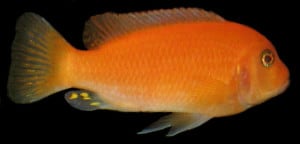
Common name: Red Zebra, Orange Zebra
Scientific name: Metriaclima Estherae
Average Adult Fish Size: 12cm / 4 Inches
Place of Origin: Lake Malawi
Typical Tank setup: Rocky Malawi tank
Recommended Minimum Aquarium Capacity: 120 Litres
Compatibility: Combine with other Malawi mbuna species
Temperature: 23-28 Deg C / 73-82 Deg F
Water chemistry: pH 7.6-8.6
Feeding: Omnivorous but does better with vegetables. Should not have too much protein and should have no fat. African cichlid flake or pellt foods are good as a staple, but the diet should be supplimented with fresh green vegetables such as spinach, romaine lettuce, peas or zucchini.
Sexing: The colorations of this fish differ from most of the Mbuna, as the females are typically the ones displaying the deeper and more brilliant colorations. The orange males are larger but often become pale on the lower sides of their bodies, and may even show a brilliant “freckling” of spots along the dorsal and tail fins. While the smaller female, may not have any color variation, with the deep orange color extending out to the tips of her fins. The males typically will have numerous (4-7) “egg spots”, while the female may show fewer (0-3) and less prominent “egg spots”.
Breeding: Breeding these fish can be quite rewarding, as they are quite beautiful in their spawning and brooding rituals.
Additional Information: A member of the Mbuna (or “Rock Dwelling” cichlid) family, their environment should be densely decorated with rocks and rock caves, fine gravel, fine gravel with crushed coral, or even sand for substrate, driftwood, Java Ferns, and Java Moss. Top, middle and bottom swimmers, their preferred tankmates may include other Mbuna or Malawi cichlids, and Synodontis catfishes (as bottom feeders). Red Zebras are Omnivores, and do well with fresh spinach, peas, zucchini, and lettuce. Live foods may include crickets, brine shrimp, meal worms, glass worms, and tubifex worms. Frozen foods like beef heart, hi-pro, daphnia, glass worms, plankton, and brine shrimp are also good choices. Remember, as with most members of the Mbuna family, too much protien foods (meat) may cause them to “bloat”. 30% water changes weekly. Vacuum substrate every 2 weeks, move the rock structures at least once a month, possibly with each substrate cleaning, as this will help to curb the territorial instincts of most Mbuna.

Related Posts
Croaking Gourami – Trichopsis vittatus
Paradise Fish – Macropodus opercularis
Schubert’s Barb – Barbus Semifasciolatus